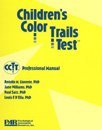
Childrens Color Trails Test cctt
For: Measure sustained attention, sequencing and other executive skills in ages 8-16 years
Reading Level: Child - Adolescent
Format: Paper-and-Pencil
Length: Approximately 5-7 minutes (timed)
Scoring: Hand Scored
Printed Kits
Click to browse products
Printed Forms & Handscoring Materials
Test forms, response booklets and scoring reference manuals.
CCTT Introductory Kit
CCTT Form K, Parts 1 and 2 (50)
CCTT Form X, Parts 1 and 2 (50)
CCTT Form Y, Parts 1 and 2 (50)
CCTT Form Z, Parts 1 and 2 (50)
Authors
Antolin M. Llorente, PhD, Jane Williams, PhD, Paul Satz, PhD, Louis F. D’Elia, PhD
Description
The Children’s Color Trails Test (CCTT) was developed to meet the increasing need for a children’s instrument to assess sustained attention, sequencing, and other executive functions while reducing reliance on language and diminishing the effects of cultural bias and parental verbal report. The CCTT retains many similarities to the original children’s version of the Trail Making Test (TMT), but substitutes the use of color for the use of letters from the English alphabet, thereby increasing the suitability of the test within cross-cultural contexts and with other special needs populations.
The CCTT is firmly rooted in child development and maturational theory, developmental neuropsychology and child neurology. The salient features, colour and number were chosen because these characteristics are easier for children to process and recognise than letters. Extensive research confirms that the recognition of both colour and number is consistent with the cognitive maturation of young children. The test addresses the applied psychometric and theoretical concerns about other childhood tests of attention, including the improvement of the assessment of children who are illiterate who are in cross-cultural contexts or whose primary language is not English and those who suffer from neurological deficits including language and learning disabilities.
The test can be administered using non verbal instructions if necessary.
Normative data has been collected from 678 healthy children ages 8-16 years; normative data has also been collected from more than 500 children from various clinical groups that participated in the CCTT validation studies.
Reliability – Alternate-form reliability between Form K and Form X for the CCTT-1 and the CCTT-2 was .85 and .90, respectively. Time raw scores for the CCTT-1 and CCTT-2 exhibited good temporal clinical stability ranging from .90-.99 across various time intervals.
Validity – Demonstrates a good level of convergent validity with the Children’s Color Trail Making Test and other instruments designed to assess attention. CCTT scores also have been found to be sensitive indicators of the cognitive impairment associated with various neuropsychological and psychiatric disorders such as Attention Deficit/Hyperactivity Disorder.
Note: Form K is the standard test form for which normative data were collected and should be used for clinical evaluation. Forms X, Y, and Z should be used in research. Stopwatch is required for administration.
NB: Prices are in Australian dollars inclusive of GST. NZ customers need to log in to view ex-GST prices.



